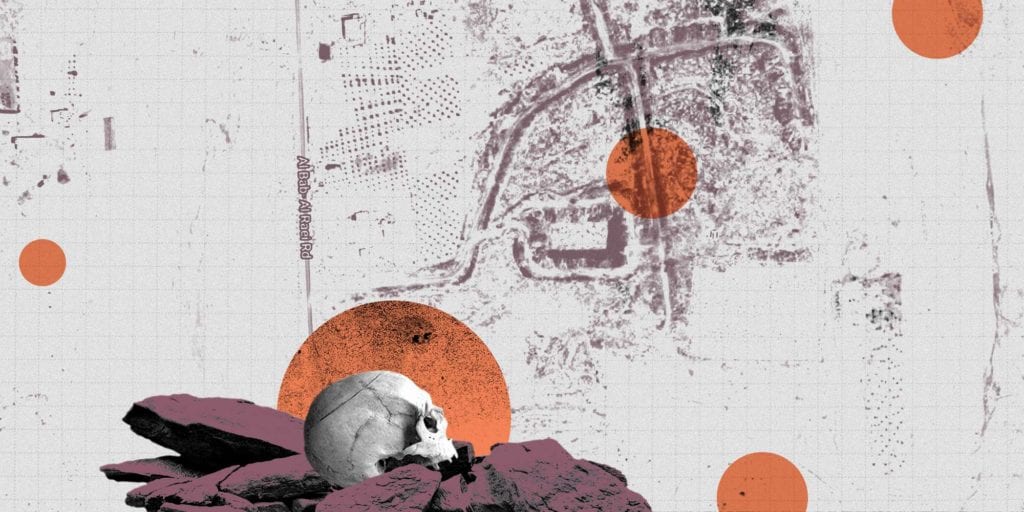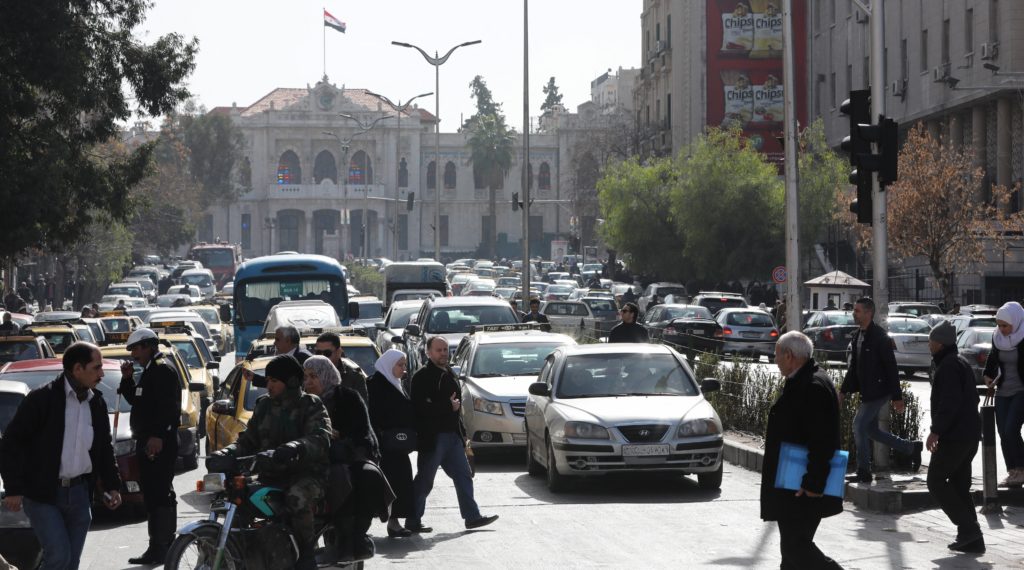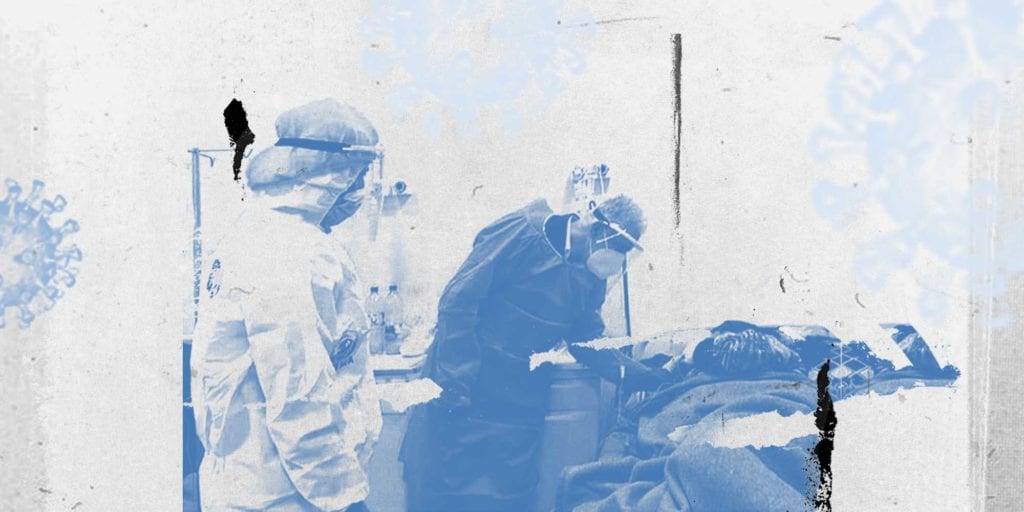Anwar al-Muhammad was wandering around the garbage dump like he had done for years, looking for anything of value that could be traded or sold, when he suddenly smelt a strange smell. It was moldy mixed with the reek of flesh. At first he thought it was a dead dog.
What the 35-year-old garbage collector found instead in the landfill in the village of Hadath east of Aleppo would turn his life upside down, and turn him into a very rich man.
As it turned out, the smell emanated from the partly decomposed body of someone recently liquidated by the Islamic State of Iraq and Syria (ISIS). “If it were not for the remains of God’s creation, I would not have been able to build my house on the land I inherited from my father,” said Anwar pointing at his home. “Look, it has a courtyard and stone fences. And I have planted olive seedlings.”
Having dug a hole next to the dump Anwar buried what was left of the corpse. He feared leaving it out in the open might attract stray dogs. This was in August 2014.
Like most people in the region, Anwar did not know why ISIS killed these people and dumped their bodies the way they did. Yet, on the foreheads of most of the bodies ISIS fighters had written in blue or black “infidel” or “apostate.”
“After the first corpse had been dumped, many others followed,” Anwar explained. “Most bodies had ropes around their feet, hands or necks. Initially, the ISIS fighters warned me that if I were to recognize a body and contact the family, my place would be among the dead.”
Like most people in the region, Anwar did not know why ISIS killed these people and dumped their bodies the way they did. Yet, on the foreheads of most of the bodies ISIS fighters had written in blue or black “infidel” or “apostate.”
ISIS used to throw bodies in wells, dry streams or river beds and garbage dumps, according to reports issued by both local and international human rights organizations.
Anwar gradually became aware that the bodies had a value and price, as some point he started selling them to the victims’ relatives. “That’s how I made the money I would never have made just working in a landfill,” he said.
13th Century Fatwa
From 2013 to 2015, more than 20 mass graves were found across Syria, containing thousands of bodies. One of the most famous places where ISIS used to dump its victims is the 50-meter deep Al-Hota pit, located some 85 kilometers from the northern city of Raqqa.
“The Al Hota gorge was once a beautiful natural site,” said Syrian researcher Sarah Kayyali in Into The Abyss, a report issued by Human Rights Watch (HRW) in May last year. “It became a place for terror and punishment.”
During our 18-month investigation in Syria and neighboring countries, we did many interviews and obtained photographs confirming the trade in dead bodies. We tracked four cases in different geographical areas to ensure there is a pattern to the trade which has made some individuals involved in the conflict very rich indeed.
In the governorates of Deir Ezzor and Raqqa and the countryside of Aleppo, ISIS did not give the bodies to the families, based on a fatwa issued by the 13th century Islamic scholar Ibn Taymiyyah, which states it is forbidden to bury an “apostate” in a Muslim cemetery. And so ISIS threw them in wells, dumps and large pits instead.
In 2015, one family was searching the dumps in the countryside north of Allepo for the body of their son, who had been killed by ISIS for “dealing with foreign parties.” The family met Anwar and offered him $7,000 for finding their son, after they had been told his body was thrown onto a village dump. They even told Anwar not to worry “if the corpse were decayed, for they could still recognize it from the teeth.”
Anwar told the ISIS fighters who regularly came to the dump to throw bodies about the family looking for their son. They demanded $10,000 for the body. Anwar would get a commission of 100,000 Syrian pounds.
8,143 People Still Missing
“The Islamic State’s (ISIS) expansion in Iraq and Syria featured horrendous public abuses,” HRW stated in its report Kidnapped By ISIS, which was issued in February 2019. “Largely unseen but equally egregious were the widespread detentions and kidnappings – thousands of people snatched from their homes and cars and at checkpoints, who subsequently went missing.”
While the full scale of the missing is not known, the Syrian Network for Human Rights (SNHR) has reported more than 8,143 cases of individuals detained by ISIS whose fates remain unknown. The majority of those taken were men. But HRW also documented the disappearances of several women.
“ISIS members would ask for money in exchange for informing families about the fate of their son,” Anwar said. “People did not bargain a lot.”
When we were researching other waste dumps in the Aleppo countryside to confirm what Anwar told us, one worker there told us: “They were throwing bodies, once or twice a day. And I also saw them take bodies from the dump.”
Yasser Al-Najjar used to work as an official for the Syrian military authorities negotiating the exchange of prisoners and dead bodies. “ISIS at times had crippling conditions in their requests,” he said in his office in Kilis in southern Turkey. “But that did not stop them from selling bodies for money. In the shadows, far away from media and cameras, anything is possible in Syria.”
SNHR director Fadel Abdul-Ghani told us how one of his teams once witnessed an exchange between the Syrian regime and opposition factions,
in which the bodies of Iranian militants were handed over in return for the release of detainees.
Read Also:
In Damascus
A Syrian man currently living in the Swedish capital Stockholm used to work for a public funeral service in Damascus which transported bodies to cemeteries on a daily basis. At first, he refused to speak with us, but after several calls he finally agreed to give us his testimony on the condition of anonymity.
“Our assignment was to transport bodies from the Tishreen Military Hospital and the Mezzeh 601 Military Hospital to two large cemeteries in Qatifah, north of Damascus, and one in Najha, south of the capital,” he said. “The car looked like a decorated box with pictures of Bashar al-Assad on all sides, so we could pass all checkpoints.”
“Some corpses had specific numbers or signs on them, which we would bury next to the mass grave,” he continued. “The others were thrown into the mass grave, one on top of the other, and covered with sand by a bulldozer.”
“The corpses which the officers had marked, we would later take out and hand back to them,” he added, after pausing to drink a cup of water. “For each body, they demanded some $1,500 to $3,000 from the victims’ families.”
He then made us listen to audio recordings and phone messages of conversations between him and the military and security officers. He estimated the total number of bodies he contributed to selling at 125.
According to HRW, the Syrian regime arrested and forcibly disappeared tens of thousands of people. The detention centers under its control are known for the widespread and systematic use of torture, and catastrophic living conditions. According to the SNHN, there are still some 130,000 detainees in the detention centers of the Syrian regime, including 7,913 women and 3,561 children, which represents 88.5% of all detainees in Syria.
The Corpse Market
In August 2020, 30-year-old May learnt that her husband Zaid Jibril had been killed three years after his arrest by the Syrian regime’s security forces for “organizing anti-regime demonstrations.” He was buried in the Qatifah cemetery north of Damascus, May said she was forced to sell her house to be able to pay $7,000 to an officer in the Syrian security services through a local broker, who then brought her husband’s body, so she could bury it.
“I thank God I was able to obtain my husband’s body so our children can visit,” said May by Skype from a refugee camp in the northwestern state of Idlib. “Many families paid money to regime officers and brokers. Many sold everything they owned to obtain news of their loved ones.”
“Trading in corpses, mortgaging them to exchange or sell them is considered a crime against humanity by the Rome Statute of the International Criminal Court,” said legal expert Hussein Hamadeh.
According to him, any assault on or mutilation of corpses, leaving them in the open, not allowing them to be buried, using them as tools of political pressure or selling them violates international law. Authorities are furthermore not allowed to intentionally withhold information about those missing, given the level of anxiety and mental stress it produces for friends and families. When the person in question dies, the authorities must provide the family with information regarding the place of burial.
Five Bodies Ahmed Al-Sayed’s family learnt that one of their sons had been arrested by the Syrian Democratic Forces (SDF) during their control of the city of Raqqa in October 2017.
The young man was arrested after an airstrike near the Abu Al-Hays intersection. The 34-year-old was transferred to a nearby medical center. His father told us that the family had asked all the center’s health workers about their son, but at first they could not find him.
A few days later a military source told the family their son had been killed. Obtaining the body would cost them $10,000. “We paid the full amount to a SDF commander through a local broker and started digging near the archaeological park in Raqqa,” said Ahmed’s brother. “We found five bodies, one of which was my brother. We reburied the others in the same place, while we took my brother’s body to the family cemetery on the outskirts of Raqqa.”
We requested representatives of the Autonomous Administration of North and East Syria, as well as the Syrian Ministry of Interior to comment on our findings, yet did not receive a response.
As soon as the burial begins, the march of Abu Al-Ward begins too. And of all others who work just like him.
The March of Abu Ward
Abu Al-Ward is a local broker in the city of Idlib. After burying some bodies, he and three young men set out to search for a corpse that someone had asked for in exchange for $3,000.
In the center of Idlib, you can see bodies entering the forensic medical center on a daily basis. They were found, or belong to people killed in mysterious circumstances. Some 75 bodies a week arrive, according to the center’s documentation office.
“There are bodies that the courts and hospitals refuse to hand over to their families, especially those known as Shabiha [gangs closely related to the Baath Party],” said Abu Al-Ward by WhatsApp. “What follows is the process of handing over the body and receiving the money.”
“The body remains in the fridge for some 15 days to a month,” said Ali Al-Taqash who works at a medical center. “Samples for DNA testing are stored to facilitate future identification.”
As soon as the burial begins, the march of Abu Al-Ward begins too. And of all others who work just like him.
Read Also:
The Corpse in the Well
On January 6, 2014, the family of Mohamad al-Ali (a pseudonym) managed to obtain his body, which had been thrown in a well near the town of Deir Sunbul in the Idlib countryside.
Mohamad had been kidnapped at a checkpoint of the Syrian Revolutionaries Front (SRF) and was later liquidated by a gunshot to the head
“After negotiations that lasted for days, we paid a local mediator $10,000 and the SRF allowed us to extract the body from the well,” said the young man’s family.
Local activists we met in the north of Syria and Turkey said they witnessed the sale of at least five bodies between January 2012 and March 2014. Their statements were backed by photographs and videos of the negotiations and sale, which are in our possession.
Military Gains
On the road between the Jenderes border crossing and the village of Qatma north of Aleppo, we met Abu Jaafar, who used to be responsible for forensic medicine in the opposition-held areas east of Syria until late 2016.
He had witnessed the exchange of bodies between the armed opposition and the regime and pointed at another dimension of the trade, which reflected military gains in the war.
“The body of one fighter in an Iranian-backed militia was exchanged for five or six detainees alive in the prisons of the Syrian regime,” he said.
The Syrian war has witnessed countless negotiations and exchanges of bodies and prisoners between the regime and the opposition. In August 2012, the Al-Baraa Brigade in Eastern Ghouta concluded a deal with the regime to release over 2,000 detainees from Syrian prisons, in exchange for the release of 48 Iranians, most of them belonging to the military.
“Any assault on a corpse is considered a crime prohibited in international law,” said SNHN director Abdul-Ghani. “Take the The Hague Convention on respecting the laws and customs of war, which clearly stipulates a commander is responsible for all actions of people under his command, and calls for respecting the dead and preventing the remains from being despoiled.”
This investigation was carried out under supervision of the Syrian Investigative Journalism Unit Siraj and edited by Mohamed Bassiki.
Read Also:











